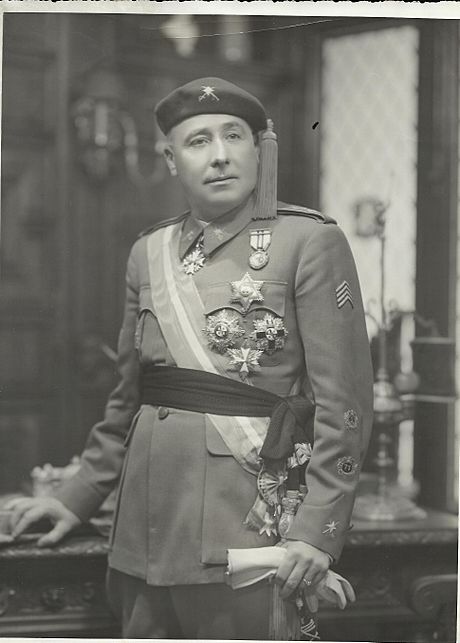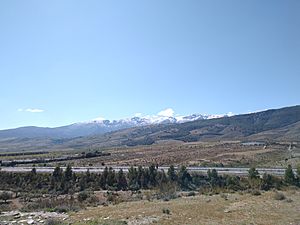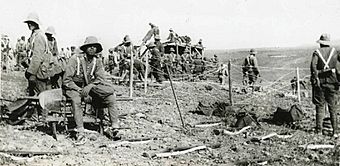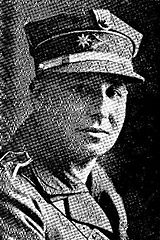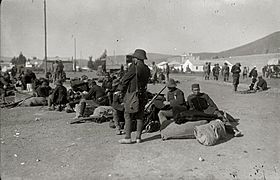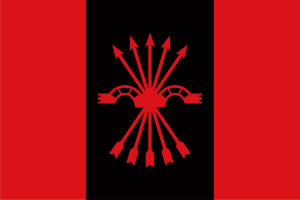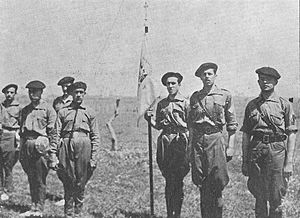Ricardo Rada Peral facts for kids
Quick facts for kids
Ricardo Rada Peral
|
|
|---|---|
|
|
|
| Born | 1885 Málaga, Spain
|
| Died | 1956 Madrid, Spain
|
| Nationality | Spanish |
| Occupation | professional officer |
| Known for | military |
| Political party | Falange, Carlism |
Ricardo Rada Peral (1885-1956) was a Spanish military officer. He became a lieutenant general, a very high rank in the army. He spent 12 years in Morocco, fighting in battles and serving in garrisons. During the Spanish Civil War, he fought for the Nationalists. He even commanded large groups of soldiers called a corps.
In the 1940s, Ricardo Rada was the first leader of Spain's first armored division, which used tanks. His highest job in the army was commanding the II. Military Region in Seville from 1946 to 1952. He is most famous for training and leading special groups of soldiers. These groups were part of political movements like the Falangists (called Primera Línea) and the Carlists (called Requeté).
Ricardo Rada was not involved in politics until the 1930s. He briefly joined a group called Falange Española. Later, he became part of the Comunión Tradicionalista and joined the top Carlist leaders during the war. After the war, he supported the Francoist regime and stopped his political party work.
Ricardo Rada's Early Life and Family
Ricardo Rada came from a family in Andalusia, Spain, with a long history in the military. His grandfather, Ricardo Rada Martínez, was a member of the Guardia Civil. He fought in wars and received honors for his bravery. Ricardo's father, Ricardo Rada Cortines, also joined the Guardia Civil and later the infantry. He became a general de brigada before he retired.
Ricardo's mother was Natalia Peral Obispo. She came from a family that owned land. Ricardo was the second of nine children and the first son. Not much is known about his childhood. He started his military career at age 21. In 1906, he joined the infantry academy in Toledo. He finished his training in 1909 and became a segundo teniente, a low-ranking officer. His first job was in Badajoz.
In 1911, Rada married Presentación Martínez Martínez. They had five children. Two of his sons, Ricardo and Francisco, also joined the army. Other family members, like his brothers José and Rafael, also became officers. Sadly, José and Rafael died in Morocco.
Becoming a Junior Officer
After two years in Badajoz, Rada was promoted to primer teniente in 1911. In 1913, he was sent to Morocco for the first time. This was during a war period called Campaña de Yebala. He was in many battles, including skirmishes at Malalien and Río Martín. In 1915, he received his first military honor, the Cruz del Mérito Militar. In 1916, he became a capitán.
Rada returned to Africa in 1920. He was part of the Battle of Annual in 1921. His unit survived and was sent to Melilla for support. He led many combat missions, sometimes even leading bayonet charges. He served under famous generals like José Sanjurjo. In 1922, his regiment received a special honor called Medalla Militar Colectiva. In August 1923, he was promoted to comandante because of his bravery in battle.
Rising as a Senior Officer
After a change in government in 1923, Ricardo Rada was sent to Vera in Almería. His job was to help reform the local government and encourage patriotism. In 1924, he was sent back to Morocco.
His third time in Africa lasted almost seven years. He joined the Spanish Foreign Legion, a special military unit. He fought bravely in eastern Morocco and was wounded twice. He recovered and continued to lead his troops. In 1926, he took part in the Alhucemas landing, an important military operation. During this time, he worked closely with future famous generals like Francisco Franco and Emilio Mola. He received several military awards, including the French Legion of Honour in 1928. By 1929, he was a teniente coronel.
In 1927, the fighting in Morocco ended. Rada was given command of the Touima garrison. When the Republic was formed in 1931, the government wanted to reduce the size of the army. In June 1931, Rada moved from active service to the reserve. He retired as a 46-year-old officer and settled in Almería. He later worked for a tobacco company.
Early Political Involvement
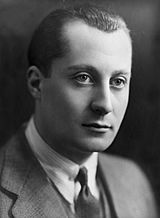
During the time of the Republic, Ricardo Rada became more involved in politics. He started to support extreme right-wing groups. Many historians believe he joined the Falange Española, a new political party. He often met with important Falange leaders like José Antonio Primo de Rivera in Madrid.
Around 1933 or 1934, Rada helped create the Falange's special militia, called Primera Línea. He was a key person in organizing and training these soldiers. He taught them how to handle weapons. However, Rada had some different ideas from other Falange leaders. In early 1935, he and a group of others left the Falange.
In late 1933, Rada also joined a secret military group called Unión Militar Española (UME). This group acted like a union for army officers and also pushed for political changes. Rada was one of the main leaders in the UME. He worked to connect the UME with different political parties, including the Falangists, Alfonsists, and Carlists. In the final months of the Republic, Rada was actively involved in planning against the government.
Joining the Carlist Movement
Ricardo Rada joined the Carlists, another traditionalist political group, in early 1935. Like in the Falange, his main job was to train the Carlist militia, known as the Requeté. He became the Inspector General of the Requeté. Rada was very important in building up the Carlist military force. By the spring of 1936, the Requeté had 10,000 fully armed and trained men. They were a "genuine citizen army" ready for small military operations.
Rada often appeared at Carlist public events. In the general elections of February 1936, he ran as a Carlist candidate but did not win. After that, he focused completely on planning military actions for the Requeté. He was part of a special military committee formed by professional officers.
In June 1936, Rada worked hard to connect the Carlist plans with the UME's conspiracy. He helped coordinate military preparations in Almería and nearby areas. Within the Carlist movement, he focused on Navarre, visiting towns to make sure everything was ready for an uprising. Historians say he was a "valuable link" between the Carlists and the conspiring officers. He pushed for the Carlists to join the uprising quickly, even if they didn't get all the political promises they wanted.
Ricardo Rada's Role in the Civil War
When the military uprising began in July 1936, Rada was in Navarre. He led a group of rebel soldiers from Pamplona. They fought for control of mountain passes in the Sierra de Guadarrama. In August and September, Rada led his men in battles for Puerto de Lozoya. He was promoted to full coronel. By December, his headquarters were in Leganés.
From early 1937, Rada commanded mixed units, including Requetés and Moroccan soldiers. His troops captured important areas like Cerro de los Ángeles. In February and March, he played a key role in the Battle of Jarama, a major and bloody battle. In April, he took command of the 2nd Brigade.
In the summer of 1936, Rada joined the Carlist wartime executive committee. He showed loyalty to the new Carlist leader, Don Javier. However, he did not resist when the Carlist party was forced to merge into a new state party, Falange Española Tradicionalista (FET), in May 1937. He became one of the two deputy commanders of the new FET militia.
In July 1937, Rada became the Military Governor of Cáceres. He commanded the provincial frontline there. In March 1938, his division was moved to the border of Soria, Zaragoza, and Guadalajara provinces. After some fighting, they moved to the Calatayud area. Rada was promoted to Brigadier.
In late May, his troops advanced into Catalonia. In August, his division fought fiercely in the Ebro bend, including battles at Villalba dels Arcs. In November 1938, Rada took command of the Cuerpo de Ejército Marroquí (Moroccan Army Corps). His corps reached the outskirts of Valencia by the end of the war.
Post-War Military Career
In late 1939, Rada briefly commanded the Cuerpo de Ejército de Castilla. He then took command of the 13th Division in Barcelona. He was also made inspector of armored troops, a new part of the Spanish army. He received many honors and awards for his service. In 1940, he visited Nazi Germany to learn about tank warfare. He received the Verdienstorden vom Deutschen Adler from Germany, as well as honors from Portugal and Italy.
In 1942, Rada was promoted to division general. In 1943, he became the commander of the División Acorazada, Spain's first armored division. He held this important position until 1945.
In the mid-1940s, Rada temporarily commanded the I. Military Region (Madrid). In 1945, he became commander of the Cuerpo de Ejército de Maestrazgo. In 1946, he was promoted to teniente general, his highest rank. He took command of the II. Military Region (Seville) and the Cuerpo de Ejército de Andalucia. He held this position for six years until 1952. After that, he became the director of the Museo del Ejército in Toledo. He led the museum until his death in 1956.
After the war, Ricardo Rada remained loyal to Francisco Franco, Spain's leader. He received high honors, including the Gran Cruz de la Orden del Mérito Civil in 1948. Although some people in the Falange saw him as a traditional monarchist, he was fully integrated into the Francoist regime. While he may have kept some Carlist sympathies, he was no longer actively involved in Carlist politics after the war.
See also
 In Spanish: Ricardo Rada para niños
In Spanish: Ricardo Rada para niños
- Falange Española de las JONS
- Carlism
- Traditionalism (Spain)
- Armoured Division No. 1 "Brunete"


